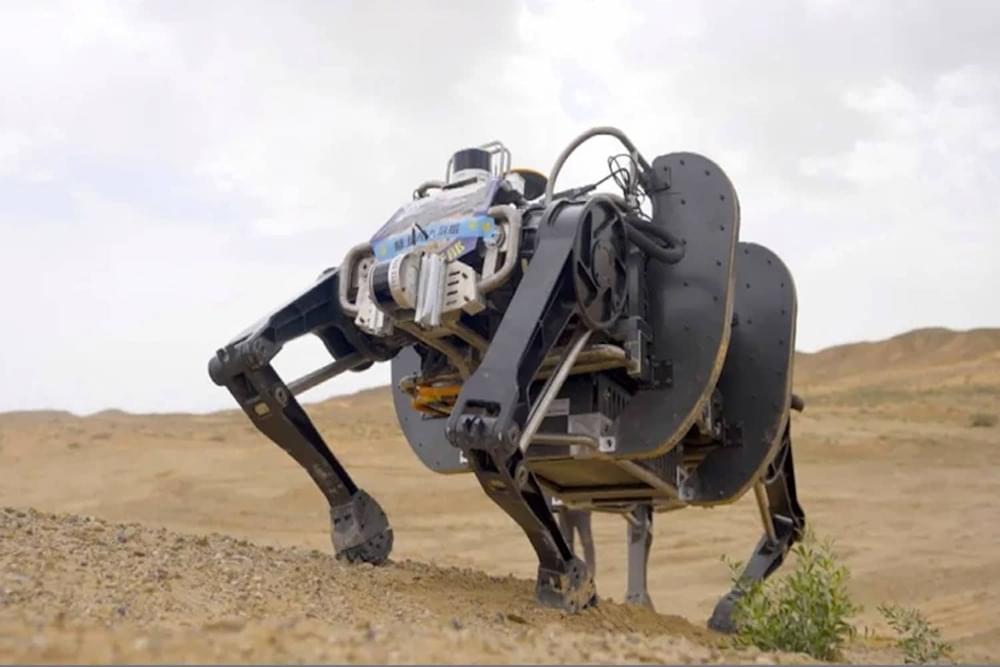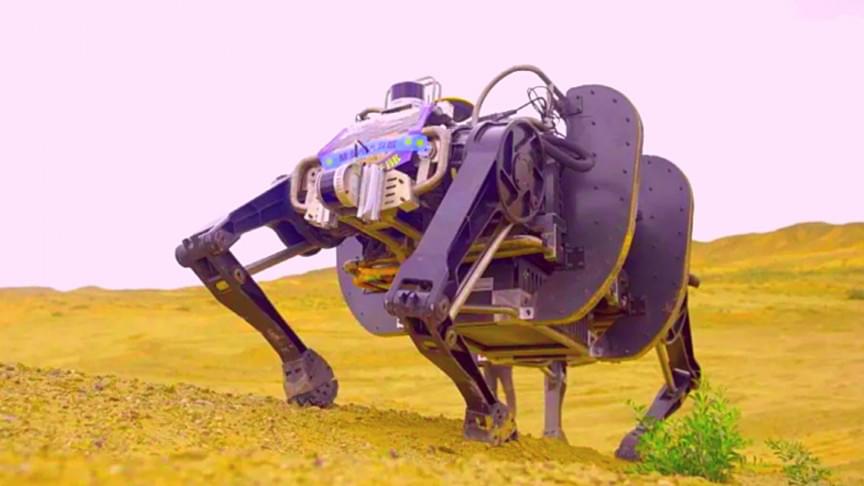🔔 Subscribe now for more Artificial Intelligence news, Data science news, Machine Learning news a…
Category: transhumanism – Page 31

China develops world’s largest quadruped bionic robot with off-road capabilities
China has developed the world’s largest electrically-powered quadruped bionic robot to assist the military on logistics and reconnaissance missions. This comes as the latest in China’s push to become a global leader in robotics by 2025 and also, of course, in military tech.
Walking on four legs and boasting a yak-like appearance, the robot is not only huge but powerful, smart, and surprisingly agile. It can move forward and backward and can perform a series of unexpected movements, such as jumping, running, turning, or walking diagonally.
This mechanical beast is strong enough to carry up to 350 pounds (160 kg) and can sprint at 6 mph (10 km/h). The robot is more than half the height of an adult when walking, and its length is about twice its height. Thanks to an unconscionable 12 sets of joint modules, it even sprints and dashes and jumps high without losing its footing.

China’s New Electric Quadruped Robot Could Be the Largest in the World
And it looks like a big yak.
China’s state media, the Global Times, claims the country has developed the world’s largest electric-powered quadruped bionic robot. And to be honest, that thing looks just like a yak.
Bizarre appearances aside, this comes as the latest in China’s push to become a global leader in robotics by 2025. And also, of course, in military tech.… See more.
China claims that it has developed the largest electric-powered quadruped robot in the world! And the nation is rapidly approaching its 2025 goal.
How To Build The Universe in a Computer
This series is absolutely fantastic. Especially for Transhumanist non-astrophysicists like me!
Thank you to Wren for supporting PBS. To learn more, go to https://wren.co/start/spacetime.
PBS Member Stations rely on viewers like you. To support your local station, go to: http://to.pbs.org/DonateSPACE
Sign Up on Patreon to get access to the Space Time Discord!
https://www.patreon.com/pbsspacetime.
We routinely simulate the universe on all of its scales, from planets to large fractions of the cosmos. Today we’re going to see how it’s possible to build a universe in a computer — and see whether there’s a limit to what we can simulate.

Bionic Eyes: Developing the Next Generation of Artificial Vision AIDS
A new technology solution that will provide low-power systems for use in bionic eyes, has been jointly developed by academics from the Harbin Institute of Technology in China and Northumbria University.
Working in partnership with a research group led by Professor PingAn Hu from the Harbin Institute, Northumbria’s Professor Richard Fu described their newly developed method for controlling the artificial synaptic devices used in bionic retinas, robots, and visual prostheses, as a “significant breakthrough.”
The team discovered that injecting elements of the soft metal, indium, into a two-dimensional (2D) material called molybdenum disulfide (MoS2), could improve electrical conductivity and reduce power consumption of the optical synapses used in the development of bionic eyes.
Transhumanism (Full Documentary)
TABLE OF CONTENTS —————
0:00–21:02 : Introduction (Meaning of Life)
21:03–46:14 CHAPTER 1: Transhumanism and Life Extension.
TWITTER https://twitter.com/Transhumanian.
PATREON https://www.patreon.com/transhumania.
BITCOIN 14ZMLNppEdZCN4bu8FB1BwDaxbWteQKs8i.
ETHEREUM 0x1f89b261562C8D4C14aA01590EB42b2378572164
LITECOIN LdB94n8sTUXBto5ZKt82YhEsEmxomFGz3j.
#1 ) THE GENETIC PATHWAY
46:15–58:52 CHAPTER 2 : Biological Aging a. “Programmed Cell Death” Theory of Aging b. “Intercellular Competition” Theory of Aging c. “Antagonistic Pleiotropy” Theory of Aging.
#2 ) THE CYBERNETIC PATHWAY
58:53–1:12:26 CHAPTER 3 : Cyborgs.
The Omega Singularity: A Missing Piece in Quantum Cosmology
COUNTDOWN TO RELEASE: Here comes the next and final installment in The Cybernetic Theory of Mind series ― The Omega Singularity: Universal Mind & The Fractal Multiverse ― which is now available to pre-order as a Kindle eBook on Amazon. In this final book of the series, we discuss a number of perspectives on quantum cosmology, computational physics, theosophy and eschatology. How could dimensionality be transcended yet again? What is the fractal multiverse? What is the ultimate destiny of our universe? Why does it matter to us? What is the Omega Singularity? These are some of the questions addressed in this concluding volume of my eBook series.
#OmegaSingularity #UniversalMind #FractalMultiverse #CyberneticTheoryofMind #EvolutionaryCybernetics #PhilosophyofMind #QuantumCosmology #ComputationalPhysics #futurism #posthumanism #cybernetics #cosmology #physics #philosophy #theosophy #consciousness #ontology #eschatology
This final book V of The Cybernetic Theory of Mind series is an admittedly highly speculative theoretical work where we’ll be testing the limits of our imagination envisioning the prospects of our distant future and the deepest secrets of hyperreality. In our fractal, computational Omniverse (all multiversal structure combined, all that is) one may assume that an infinitely large number of civilizational minds, syntellects, have followed or will follow a path, similar to ours, in their evolutionary processes. At the highest level of existence and perceptual experience, that we can rightfully call ‘Dimensionality of Hypermind’, universal minds would form some sort of multiversal network of minds, layer after layer seemingly ad infinitum.
The Cybernetic Theory of Mind series is a collection of books by evolutionary cyberneticist and philosopher Alex M. Vikoulov on the ultimate nature of reality, consciousness, the physics of time, computational physics, philosophy of mind, foundations of quantum physics, the technological singularity, transhumanism, posthumanism, the impending phase transition of humanity, the simulation hypothesis, economic theory, the extended Gaia theory, transcendental metaphysics and God. If you’re eager to familiarize with probably the most advanced ontological framework to date or if you’re already familiar with the Syntellect Hypothesis which, with this series, is now presented to you as the full-fledged Cybernetic Theory of Mind, you should get this book five of the series which corresponds to Part V of The Syntellect Hypothesis: Five Paradigms of the Mind’s Evolution.

BMW, IKEA Using AI-Powered Exoskeleton That Adds 66 Pounds Of Lift Force
2.7 billion people on this planet have “deskless jobs,” many of which require bending, lifting, moving, and carrying. German Bionic just released the fifth generation Cray X AI-enhanced power suit, or exoskeleton, to help those billions of people with almost 70 pounds of additional lifting capacity, reducing the risk of back injury and repetitive stress injuries. The Cray X is already in use at BMW, IKEA, and the French delivery service DPD, and will be launched internationally in January 2022.
The AI-powered suit boosts productivity, reduces error rates, decreases accidents, and results in a 25% reduction in the number of sick days workers take, German Bionic says.
The smart exoskeleton market has been estimated to be growing 41.3% a year to a nearly $2 billion industry by 2025, with applications in construction, shipping and receiving, healthcare, and the military. But it’s not just for the billions in the workforce.
These robotic suits supercharge human workers
Part human, part robot, all business.
This new wearable robotic suit can boost human strength, and it is powered by artificial intelligence — taking human augmentation to new levels.
What robot: German Bionic just announced an exoskeleton called Cray X with a plethora of features. It includes assisted walking, waterproofing, and an updated energy management system.
The Mind-Controlled Bionic Arm With a Sense of Touch
In the first episode of Humans+, Motherboard dives into the world of future prosthetics, and the people working on closing the gap between man and machine.
We follow Melissa Loomis, an amputee from Ohio, who had experimental nerve reversal surgery and is going to Johns Hopkins’ Applied Physics Lab to test out its latest Modular Prosthetic Limb, a cutting-edge bionic arm funded in part by DARPA. Neuro-interfacing machinery is a game changer in terms rehabilitating patients, but what possibilities do these advancements open for the future?
Follow MOTHERBOARD
Facebook: http://www.facebook.com/motherboardtv.
Twitter: http://twitter.com/motherboard.
Tumblr: http://motherboardtv.tumblr.com/
Instagram: http://instagram.com/motherboardtv.
More videos from the VICE network: https://www.fb.com/vicevideo